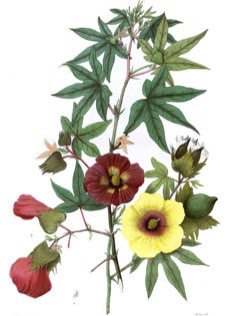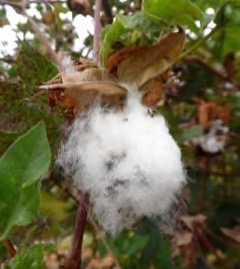 |
|
edibleplants.org |
 |
| Krzysztof Ziarnek, Kenraiz wikimedia.org |
Translate this page:
Summary
Physical Characteristics

 Gossypium arboreum is a SHRUB growing to 5 m (16ft) by 3 m (9ft) at a fast rate.
Gossypium arboreum is a SHRUB growing to 5 m (16ft) by 3 m (9ft) at a fast rate.
See above for USDA hardiness. It is hardy to UK zone 10.
Suitable for: light (sandy), medium (loamy) and heavy (clay) soils and prefers well-drained soil. Suitable pH: mildly acid, neutral and basic (mildly alkaline) soils and can grow in very acid and very alkaline soils.
It cannot grow in the shade. It prefers moist soil. The plant is not wind tolerant.
UK Hardiness Map
US Hardiness Map
Synonyms
Gossypium nanking Meyen. Gossypium obtusifolium Roxb. ex G.Don
Plant Habitats
Edible Uses
Edible Parts: Leaves Oil Seed
Edible Uses: Oil
Leaves[301 ]. The seeds contain a large amount of oil, which can be used as a substitute for olive oil[272 , 301 ].
References More on Edible Uses
Medicinal Uses
Plants For A Future can not take any responsibility for any adverse effects from the use of plants. Always seek advice from a professional before using a plant medicinally.
The juice of the root is used in the treatment of fevers[272].
References More on Medicinal Uses
The Bookshop: Edible Plant Books
Our Latest books on Perennial Plants For Food Forests and Permaculture Gardens in paperback or digital formats.

Edible Tropical Plants
Food Forest Plants for Hotter Conditions: 250+ Plants For Tropical Food Forests & Permaculture Gardens.
More

Edible Temperate Plants
Plants for Your Food Forest: 500 Plants for Temperate Food Forests & Permaculture Gardens.
More

More Books
PFAF have eight books available in paperback and digital formats. Browse the shop for more information.
Shop Now
Other Uses
Oil
The floss contained in the seedpods is used for making cloth and for the wicks of oil lamps[272 ]. Cotton fibres have a wide range of used including making clothes; rubber-tyre fabrics; stuffing material for pillows, cushions etc; surgical dressings; making twine and ropes; carpets etc[46 ]. Carbon Farming - Industrial Crop: fiber.
Special Uses
Carbon Farming
References More on Other Uses
Cultivation details
Industrial Crop: Fiber Management: Coppice Management: Standard Regional Crop Staple Crop: Oil
Tree cotton can be grown in the dry to moist tropics and subtropics, where it is found at elevations up to 1,600 metres. For commercial production it requires a climate that has a long, hot growing season with abundant moisture, followed by a drier period for harvesting the seed floss[200 ]. It grows best in areas where annual daytime temperatures are within the range 26 - 36°c, but can tolerate 18 - 38°c[418 ]. It prefers a mean annual rainfall in the range 750 - 1,250mm, but tolerates 500 - 1,500mm[418 ]. Prefers a very sunny position in a light, fertile, well-drained soil[200 ]. Plants can tolerate a range of soils, including moderate levels of salt[418 ]. Prefers a pH in the range 6 - 7.2, tolerating 5.3 - 8.5[418 ]. Requires a position sheltered from strong winds[418 ]. There are two main forms of the plant:- var. Neglecta produces very short fibres[46 ]. Var. Sanguinea produces strong, good quality fibre[46 ]. Carbon Farming - Cultivation: regional crop. Management: standard, coppice. Perennial cotton has longer fibres and is considered superior to annual cottons. Perennial cottons are suited to arid and humid conditions while annual cottons were bred for colder climates and for mechanical harvesting. Perennial cottons are cultivated in the tropics on a smaller scale and include Gossypium arboreum burmanicum, Gossypium arboreum indicum, Gossypium arboreum soudanense, Gossypium barbadense braziliense, Gossypium barbadense darwinii, Gossypium herbaceum acerifolium, Gossypium herbaceum africanum, Gossypium hirsutum marie-galante, Gossypium hirsutum punctatum, Gossypium hirsutum taitense. Currently perennial cottons are harvested by hand. Researching perennial cottons varieties and production methods would help develop them as good carbon farming plants and help to alleviate the terrible problems caused by annual cottons.
Carbon Farming
-
Industrial Crop: Fiber
Clothing, rugs, sheets, blankets etc. Currently, almost none of our fiber are produced from perennial crops but could be!
-
Management: Coppice
Cut to the ground repeatedly - resprouting vigorously. Non-destructive management systems maintaining the soil organic carbon.
-
Management: Standard
Plants grow to their standard height. Harvest fruit, seeds, or other products. Non-Destructive management systems.
-
Regional Crop
These crops have been domesticated and cultivated regionally but have not been adopted elsewhere and are typically not traded globally, Examples in this broad category include perennial cottons and many nuts and staple fruits.
-
Staple Crop: Oil
(0-15 percent protein, 16+ percent oil). Some of these are consumed whole while others are exclusively pressed for oil. Annuals include canola, poppyseed, maize, cottonseed, sunflower, peanut. Perennials include high-oil fruits, seeds, and nuts, such as olive, coconut, avocado, oil palm, shea, pecan, and macadamia. Some perennial oil crops are consumed whole as fruits and nuts, while others are exclusively pressed for oil (and some are used fresh and for oil).
References Carbon Farming Information and Carbon Sequestration Information
Temperature Converter
Type a value in the Celsius field to convert the value to Fahrenheit:
Fahrenheit:
The PFAF Bookshop
Plants For A Future have a number of books available in paperback and digital form. Book titles include Edible Plants, Edible Perennials, Edible Trees,Edible Shrubs, Woodland Gardening, and Temperate Food Forest Plants. Our new book is Food Forest Plants For Hotter Conditions (Tropical and Sub-Tropical).
Shop Now
Plant Propagation
Seed
Other Names
If available other names are mentioned here
Tree Cotton, Mpamba mwitu
Native Range
Coming Soon
Weed Potential
Right plant wrong place. We are currently updating this section.
Please note that a plant may be invasive in one area but may not in your area so it's worth checking.
None Known
Conservation Status
IUCN Red List of Threatened Plants Status : This taxon has not yet been assessed

Growth: S = slow M = medium F = fast. Soil: L = light (sandy) M = medium H = heavy (clay). pH: A = acid N = neutral B = basic (alkaline). Shade: F = full shade S = semi-shade N = no shade. Moisture: D = dry M = Moist We = wet Wa = water.
Now available:
Food Forest Plants for Mediterranean Conditions
350+ Perennial Plants For Mediterranean and Drier Food Forests and Permaculture Gardens.
[Paperback and eBook]
This is the third in Plants For A Future's series of plant guides for food forests tailored to
specific climate zones. Following volumes on temperate and tropical ecosystems, this book focuses
on species suited to Mediterranean conditions—regions with hot, dry summers and cool, wet winters,
often facing the added challenge of climate change.
Read More
Expert comment
Author
L.
Botanical References
Links / References
For a list of references used on this page please go here
A special thanks to Ken Fern for some of the information used on this page.
Readers comment
| Add a comment |
|
If you have important information about this plant that may help other users please add a comment or link below. Only comments or links that are felt to be directly relevant to a plant will be included. If you think a comment/link or information contained on this page is inaccurate or misleading we would welcome your feedback at [email protected]. If you have questions about a plant please use the Forum on this website as we do not have the resources to answer questions ourselves.
* Please note: the comments by website users are not necessarily those held by PFAF and may give misleading or inaccurate information.
To leave a comment please Register or login here All comments need to be approved so will not appear immediately.
|
Subject : Gossypium arboreum
|
|
|
|